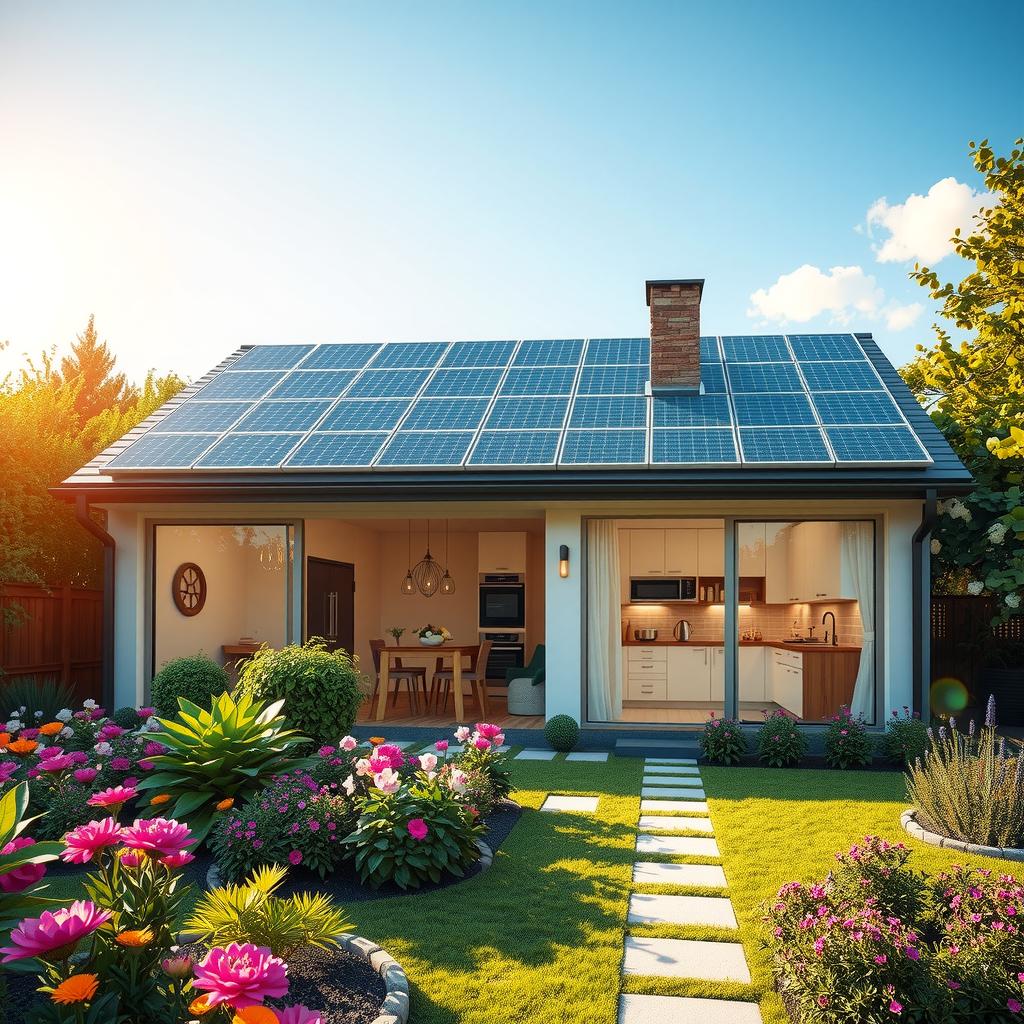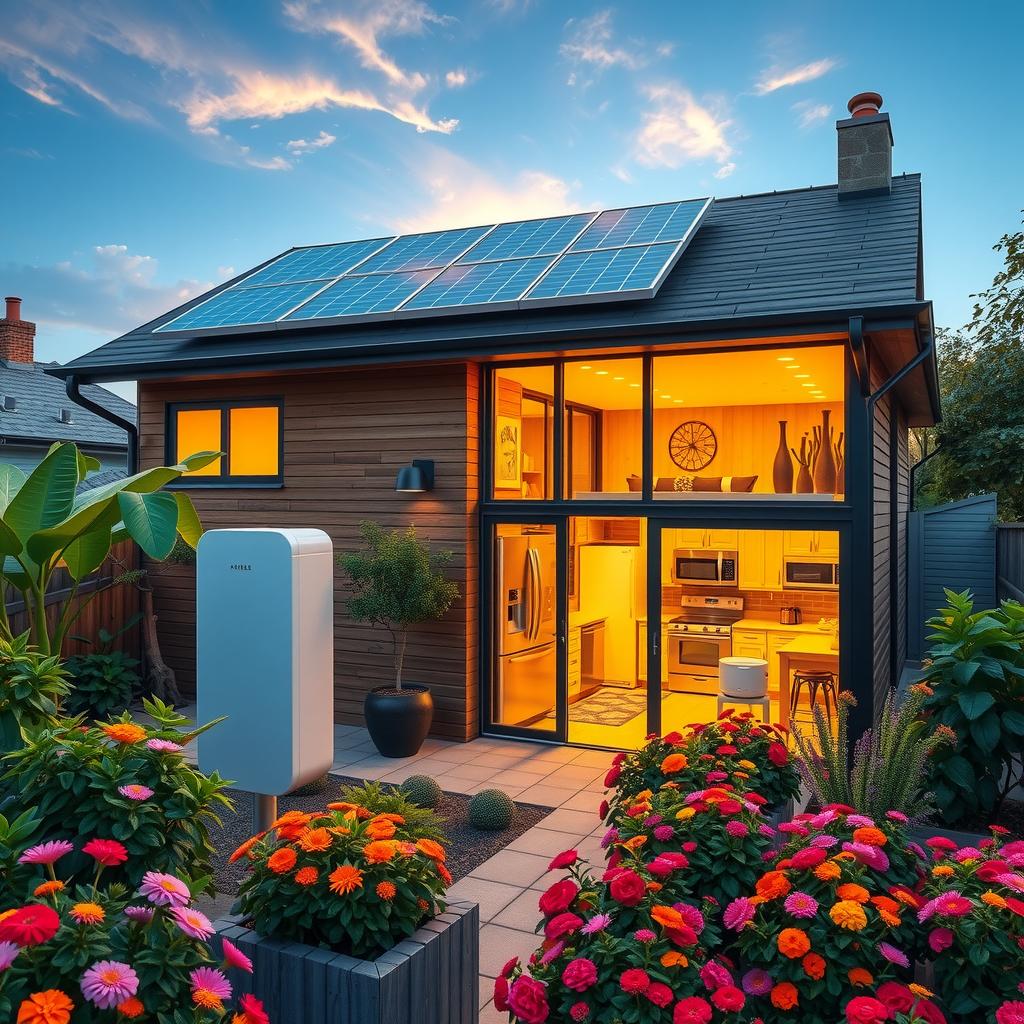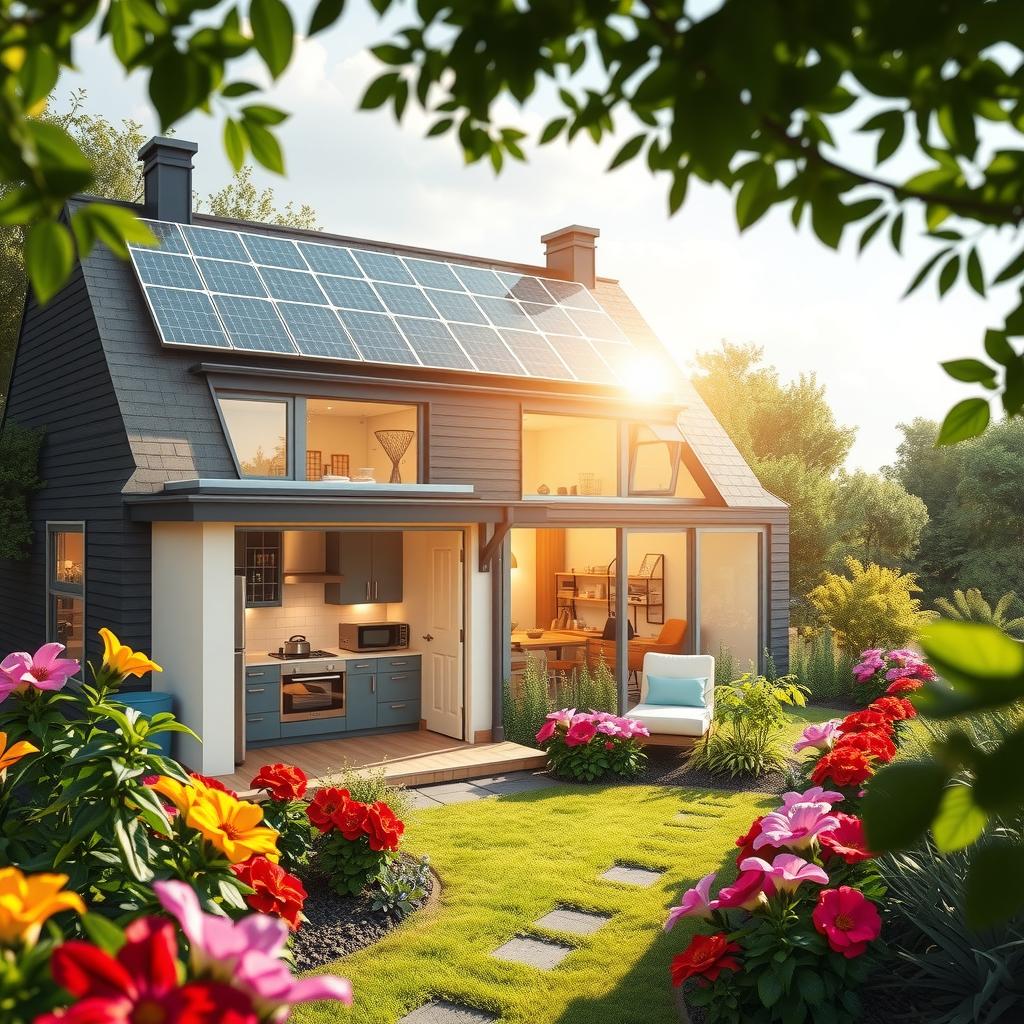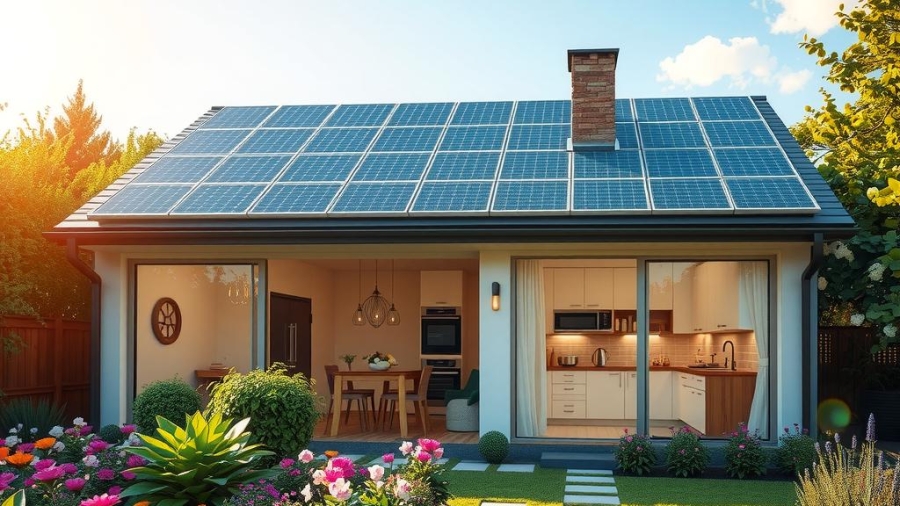In an era where climate change is at the forefront of global concerns, understanding how to enhance home energy efficiency has become an essential step for homeowners aiming to contribute positively to environmental sustainability. The journey toward carbon footprint reduction begins with a thorough home energy audit, which allows individuals to identify critical areas within their residences that consume excessive energy. By addressing issues such as inadequate insulation and air leaks, homeowners can make significant strides in improving their overall energy performance. For instance, implementing insulation improvement strategies not only helps maintain comfortable indoor temperatures but also reduces reliance on heating and cooling systems, leading to remarkable savings on utility bills.
Moreover, sealing air leaks effectively serves as a fundamental component of enhancing home energy efficiency. A well-sealed home minimizes unnecessary heat loss during winter months and keeps interiors cooler during summer. This simple yet impactful measure directly contributes to lower daily energy consumption reduction while also paving the way for further investments in energy-efficient appliances. These modern devices are designed with cutting-edge technology that uses less electricity or gas compared to traditional models—ensuring that every kilowatt-hour counts towards preserving resources.
The integration of smart home technology offers additional avenues for optimizing energy use. Homeowners can monitor their usage patterns through various applications and adjust settings remotely or automatically based on real-time data. This proactive approach not only encourages behavioral changes for energy savings but also empowers residents by providing them with actionable insights into their consumption habits. Furthermore, adopting energy-efficient lighting solutions can transform any space while significantly lowering power costs; switching from incandescent bulbs to LED options represents one of the simplest yet most effective methods available today.
As individuals consider broader steps toward sustainability, exploring renewable energy options for homes becomes increasingly relevant. Solar panels have gained popularity as an excellent investment; they harness natural sunlight and convert it into usable electricity—thus contributing substantially toward reducing one’s carbon footprint over time. Coupled with comprehensive energy management solutions, these initiatives reflect a commitment not just to personal financial benefits but also to collective environmental responsibility.
In summary, prioritizing Home Energy Efficiency paves the way for transformative lifestyle changes that resonate far beyond individual households—a crucial factor when considering our shared future on this planet.

Key points:
-
Title of the point: Conducting a Home Energy Audit
A thorough home energy audit serves as the foundation for enhancing home energy efficiency. It involves assessing various aspects of the home to determine where energy is being wasted and identifying potential improvements. This process not only helps homeowners understand their current energy usage but also pinpoints specific areas for improvement, setting the stage for effective carbon footprint reduction strategies. -
Title of the point: Improving Insulation and Sealing Air Leaks
Enhancing insulation and effectively sealing air leaks are critical components in achieving optimal home energy efficiency. By focusing on these elements, homeowners can significantly reduce heating and cooling costs while simultaneously lowering their overall daily energy consumption reduction. Proper insulation prevents heat loss during winter months and keeps homes cool in summer, directly contributing to an impressive decrease in reliance on traditional heating or cooling methods. -
Title of the point: Upgrading to Energy-Efficient Appliances and Lighting
Transitioning to energy-efficient appliances and lighting solutions is a vital step towards boosting overall home energy efficiency. Modern appliances consume significantly less electricity compared to older models, thereby facilitating substantial savings on utility bills over time. Additionally, integrating energy-efficient lighting, such as LED bulbs, not only enhances illumination quality but also plays a crucial role in minimizing both carbon emissions associated with electricity production and daily power consumption.

Understanding Home Energy Efficiency
Unlock the Secrets to Sustainable Living
In today’s world, maximizing home energy efficiency is not just a trend; it has become an essential practice for homeowners looking to reduce their carbon footprint and embrace sustainable living. A thorough understanding of how energy flows in a home can lead to significant improvements. For instance, conducting a comprehensive home energy audit allows residents to identify areas where energy waste occurs, providing insights into necessary upgrades or behavioral changes that can lead to enhanced performance.
One major aspect of improving home energy efficiency involves upgrading insulation. Poor insulation leads to considerable heat loss during winter months and excessive cooling needs in summer. By investing in quality materials and techniques for insulation improvement, homeowners can create barriers against temperature fluctuations, thereby reducing daily energy consumption significantly.
Furthermore, air leaks often go unnoticed yet contribute substantially to wasted resources. Implementing effective air leak sealing strategies helps maintain indoor temperatures by preventing conditioned air from escaping outside or unconditioned air from infiltrating inside. This step complements the overall goal of enhancing home energy efficiency.
The integration of modern technology plays a pivotal role in this transformation as well. The adoption of energy-efficient appliances minimizes power consumption while delivering optimal performance compared to traditional models. Similarly, switching to energy-efficient lighting options such as LED bulbs greatly reduces electricity use without compromising on brightness or quality.
As smart home technology continues its rise among homeowners seeking convenience alongside sustainability, many are finding value in advanced energy management solutions. These systems allow users not only full control over their home’s heating and cooling but also enable them to track real-time usage data that informs better decision-making regarding their appliance operations.
Exploring renewable energy options for homes further enhances the commitment towards environmental responsibility—solar panels being one popular choice that enables families both reduced utility bills and increased independence from non-renewable sources while contributing positively towards carbon footprint reduction efforts.
However, achieving substantial benefits isn’t solely reliant on physical modifications; behavioral changes for energy savings play an equally crucial role within households striving for improved efficiencies. Simple actions like turning off unused devices or setting thermostats wisely can collectively result in noticeable reductions in daily consumption levels.
By focusing on these interconnected aspects—from audits revealing inefficiencies through enhancements involving products like the Home Energy Efficiency, insulation strategies, technological integrations down through lifestyle choices—families pave their path toward more efficient homes while making meaningful strides toward protecting our environment.

The Role of Smart Home Devices in Energy Savings
Harnessing Technology for Efficient Living
Smart home devices have emerged as pivotal tools in the quest for enhanced home energy efficiency. These innovative technologies not only provide convenience but also play a significant role in achieving substantial energy savings. For instance, smart thermostats can learn household routines and adjust heating or cooling based on occupancy patterns. This intelligent automation reduces unnecessary energy consumption, particularly during peak hours. As a result, homes equipped with these systems witness marked improvements in their daily energy consumption reduction. Moreover, integrating smart lighting solutions further complements this effort; by utilizing motion sensors and programmable schedules, homeowners can ensure lights are only activated when needed.
Incorporating such technology into one’s living space is complemented by behavioral changes that encourage mindful usage of resources. For example, families can create awareness about turning off appliances after use or making it a habit to unplug devices that consume standby power—this simple change aligns seamlessly with the functionality offered by many smart home products. Together, these technological advancements and lifestyle adjustments contribute significantly to carbon footprint reduction.
Behavioral Changes: A Crucial Component
Shaping Mindsets for Sustainable Practices
While cutting-edge gadgets like smart plugs and programmable HVAC systems streamline processes within the home environment, they often require users to adopt new behaviors for maximum effectiveness. Implementing an effective strategy involves conducting a comprehensive home energy audit, which reveals inefficiencies related to insulation improvement or air leak sealing strategies necessary for optimal performance. Such audits serve as blueprints guiding residents toward practical actions—such as enhancing window seals or ensuring proper insulation—that complement technological interventions.
Furthermore, promoting awareness regarding energy-efficient appliances becomes crucial in encouraging sustainable habits among households. By choosing ENERGY STAR-rated products over standard ones and replacing older models with modern alternatives designed for lower power usage, families can significantly impact their overall consumption levels without sacrificing comfort or convenience.
Adjusting daily practices goes hand-in-hand with technology adoption; adopting renewable energy options for homes such as solar panels allows homeowners not just to reduce reliance on conventional electricity sources but also empowers them toward self-sufficiency while mitigating environmental impacts associated with fossil fuels.
Measurement Tools: Tracking Progress
Quantifying Efficiency Gains Through Innovation
With advancements in digital monitoring tools available through various applications today—tracking real-time data about one’s electricity use has never been easier! Users benefit immensely from insights provided via dashboards indicating how much each device consumes throughout different periods of time—a valuable resource when aiming at optimizing one’s carbon footprint through informed decision-making regarding appliance operation schedules.
Moreover, specific metrics derived from these measurements inform continuous improvement efforts whereby individuals gauge their progress against established benchmarks set forth during initial assessments like those seen following a thorough home energy audit. This process enhances accountability among all family members involved since being able to visualize collective contributions fosters teamwork towards reaching common sustainability goals!
Ultimately integrating behavior changes alongside robust tracking mechanisms drives momentum forward while enabling smarter choices around energy management solutions tailored specifically per household needs—the foundation upon which long-term success rests when striving towards elevated standards concerning overall ecological responsibility!
Integrating Renewable Energy Options
Future-Proofing Homes Against Rising Costs
As society collectively shifts toward greener lifestyles amidst rising global temperatures fueled largely by climate change concerns—we find ourselves increasingly focused on sustainable practices across every sector—including residential living spaces! One effective way individuals achieve this goal involves exploring viable avenues surrounding renewable energy options available directly within their properties enabling greater independence from traditional utility providers who may impose fluctuating rates over time unpredictable costs incurred monthly bills often strain budgets disproportionately leaving little room flexibility elsewhere financially speaking!
By installing solar panels combined strategically selected battery storage systems capable harnessing excess generated sunlight ensures availability even cloudy days guarantees reduced reliance grid supplies ultimately leads lower ongoing expenses contributing positively net annual savings realized year after year fostering sense empowerment amongst occupants themselves knowing they’re actively participating combatting climate crisis head-on whilst enjoying comfort benefits afforded modern conveniences brought about innovation coupled intentionality surrounding responsible resource utilization principles foundational underpinning every successful approach achieving true home energy efficiency aspirations envisioned together collaboratively across generations ahead!
Transforming Homes with Renewable Energy Solutions
A Pathway to Sustainable Living
The transition toward renewable energy options for homes is not merely a trend; it represents a profound shift in the way homeowners can interact with their environment. Individuals are increasingly recognizing that they hold the power to make significant contributions to carbon footprint reduction through simple yet effective changes within their residences. By incorporating Home Energy Efficiency practices, such as conducting a comprehensive home energy audit, homeowners can identify areas where improvements are necessary. This process reveals critical insights into insulation improvement, air leak sealing, and the integration of energy-efficient appliances that collectively enhance overall efficiency. Furthermore, adopting energy-efficient lighting solutions allows households not only to reduce daily energy consumption but also to enjoy long-term financial savings on utility bills.
In addition to these physical upgrades, behavioral changes for energy savings play an essential role in optimizing Home Energy Efficiency. Homeowners who become aware of their consumption patterns and implement adjustments—such as unplugging devices when not in use or adjusting thermostats—can witness immediate benefits. Smart home technology serves as an invaluable ally in this endeavor by providing real-time data regarding usage trends and enabling automated controls that facilitate optimal performance of heating and cooling systems. The synergy created between behavioral shifts and technological advancements empowers individuals with greater control over their home’s sustainability while fostering a culture of responsibility towards environmental stewardship.
Smart Technology: Empowering Efficient Management
Innovations Leading the Charge
As homeowners embrace renewable energy options for homes, smart home technology emerges as a pivotal component in achieving peak Home Energy Efficiency. Advanced systems allow users to monitor real-time data related to their daily energy consumption reduction efforts effortlessly. Many smart devices offer features like programmable settings or remote access via mobile applications that enable efficient management of resources even when residents are away from home. For example, intelligent thermostats learn user preferences over time and automatically adjust temperature settings based on occupancy patterns while ensuring maximum comfort during peak hours.
Moreover, these innovations pave the way for personalized energy management solutions tailored specifically for each household’s unique needs and preferences—further enhancing sustainability efforts without compromising lifestyle quality or convenience. In addition to managing HVAC systems effectively, many modern appliances now incorporate smart functions designed with eco-friendliness at heart; thus reinforcing ongoing initiatives aimed at carbon footprint reduction across all facets of everyday life.
Comprehensive Strategies: Insulation Meets Innovation
Building the Foundation
At its core, achieving sustainable living requires more than just technological interventions; it necessitates foundational improvements centered around aspects like insulation improvement combined with cutting-edge innovations available today under Home Energy Efficiency frameworks.Better-insulated homes provide substantial advantages by minimizing heat loss during winter months while keeping interiors cool throughout summer seasons—all contributing significantly towards lowering overall reliance on external utilities.The result? Not only do families experience increased comfort year-round but they simultaneously engage actively within broader movements aimed at reducing greenhouse gas emissions globally.
Furthermore,the importance placed upon air leak sealing cannot be overstated—it directly impacts how effectively insulation performs within residential structures.A well-sealed space ensures conditioned air remains contained whilst preventing drafts from infiltrating living areas.Incorporating both traditional methods alongside advanced materials has proven beneficial here,and results may vary depending upon specific climate conditions encountered regionally.Additional preventive measures include regular maintenance checks which serve as reminders about opportunities ripe for harvesting long-term gains through efficient design choices made early on!
By taking proactive steps involving multiple strategies employed together under one umbrella known simply—the concept behind “renewable energies” becomes tangible rather than abstract ideals reserved solely academics alone!
The Future Is Green: Collective Responsibility
A Call-to-Action
The journey toward harnessing renewable energies extends beyond individual households; it embodies collective responsibility among communities striving together towards greener futures fueled primarily by informed choices surrounding Home Energy Efficiency. This movement encourages collaboration amongst neighbors who share similar goals relating environmental concerns—creating spaces wherein information flows freely allowing everyone involved benefit mutually from successes achieved along paths traversed previously previously unexplored realms before initiating explorations collaboratively inspired visions leading future generations onward!
Engaging local governments promotes awareness surrounding subsidies available targeting investments made into renewable technologies enhances accessibility ultimately establishing equal footing regardless socio-economic standings faced today.Our planet thrives best when people unite behind common objectives aimed simplifying complex challenges posed tackling climate change head-on through actionable steps taken consistently day after day until meaningful impact realized.This shared commitment enables vibrant ecosystems flourish naturally allowing humanity coexist harmoniously alongside nature itself moving forward confidently armed knowledge gained experiences built trust relationships strengthened overtime creating brighter tomorrow awaits ahead!
Maximizing a home’s energy efficiency is essential for reducing one’s carbon footprint and creating a more sustainable living environment. A foundational step in this process is conducting a comprehensive home energy audit. This detailed assessment helps homeowners identify areas where energy waste occurs, from outdated appliances to insufficient insulation. Utilizing the insights gained from the audit allows for targeted improvements that enhance overall home energy efficiency, ultimately leading to significant cost savings on utility bills.
Improving insulation and sealing air leaks are critical measures in enhancing home energy efficiency. Effective insulation prevents heat loss during winter months and keeps homes cool in summer, reducing reliance on heating and cooling systems. Furthermore, taking steps to seal air leaks around windows, doors, and other openings ensures that conditioned air remains inside the home where it belongs. By addressing these key areas of improvement, homeowners can achieve substantial carbon footprint reduction while enjoying increased comfort throughout their living spaces.
Upgrading to energy-efficient appliances and lighting is another vital strategy within the framework of Home Energy Efficiency initiatives. Modern appliances are designed with advanced technology that consumes significantly less power compared to older models, contributing directly to lower daily energy consumption levels. Similarly, switching out traditional incandescent bulbs for LED lighting drastically reduces electricity usage without compromising brightness or quality of light. When combined with smart home technology solutions for real-time monitoring of usage patterns, homeowners can effectively manage their consumption habits and make informed decisions about their day-to-day operations.
Common Inquiries:
Q: How do I conduct a home energy audit?
A: Homeowners can perform a basic self-audit by checking for drafts around windows and doors or hiring professional services that provide comprehensive assessments detailing specific recommendations.
Q: What types of insulation should I consider improving?
A: Options include fiberglass batts or blown-in cellulose for walls; spray foam works well in attics due to its superior sealing properties against air leaks.
Q: Are there tax incentives available when upgrading my appliances?
A: Many regions offer tax credits or rebates for purchasing ENERGY STAR certified products; consulting local government websites will provide current information on available programs related to energy-efficient appliances.
